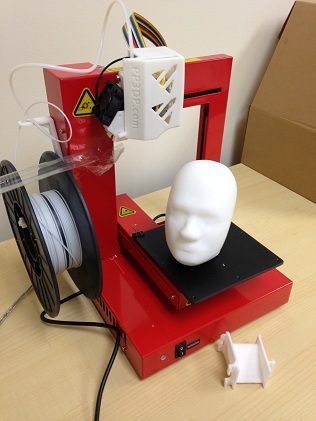
In the past, we’ve discussed a few of the extraordinary uses of 3D printing (or additive manufacturing) technology by some innovative engineers, and even printed a few of our COMSOL models. In one of our previous posts on 3D printing, we discussed some of the limitations that this technique poses from both a consumer and manufacturing stand-point — you can only print one material at a time. Now however, as was mentioned in an article in Desktop Engineering, not only is it possible to choose from a variety of materials to find one best suited to the model at hand, but it’s also possible to print multiple materials at once.

3D printer with printed COMSOL models.
Many Materials to Choose From when 3D Printing
In a recent article, Desktop Engineering editors asked a variety of additive manufacturing systems engineers and material developers to weigh in on what materials perform best when using additive manufacturing techniques. In the article, “Choosing the Best Additive Manufacturing Materials“, materials from metals to plastics to paper were discussed, and their merits for use in different types of designs. Choosing the correct materials to use in a 3D printed object is a very important step in the design process. Materials can be chosen for a variety of different reasons, such as for having characteristics that best mimic the properties of the material in the model, for cost effectiveness or print speed, or for completely different reasons, such as if the design requires that interior parts be visible (using clear materials). The materials used in a design can not only have a huge impact on print time and cost, but can also have an effect on the integrity of the printed model. Additionally, postprocessing of materials is often a required step for many additive manufacturing processes. This includes things like drilling, sanding, or machining that is needed when printing with many metal materials. In order to help determine the correct materials to use, the article goes into detail on a few different material choices and points readers to some resources offered by a variety of different companies.
So what about printing with multiple materials? Current additive manufacturing companies are moving towards a manufacturing process that will allow for multi-material 3D printed designs. As of today, the first commercial multi-material printer is Stratasys’ Objet Connex500, but many research centers around the globe are publishing papers on additional ways to print multiple materials as well. And of course, just as with single-material designs, choosing materials is also important in the manufacturing of multi-material designs. A recent blog post from Desktop Engineering titled “3D Printing Multiple Materials, Colors & Textures Gets Closer” describes some of the current processes in development for furthering the printing of multiple materials.
Further Reading
- Blog post: How to 3D Print COMSOL Models
- Blog post: Success Stories and Limitations of 3D Printing
- Article: “Choosing the Best Additive Manufacturing Materials“
- Learn about the National Additive Manufacturing Innovation Institute (NAMII), which was recently created by the U.S. government as a public-private partnership between industry and academia to accelerate the growth and development of additive manufacturing in “Taking 3D printing from prototyping to manufacturing“




Comments (0)